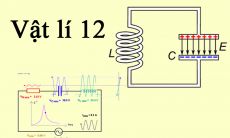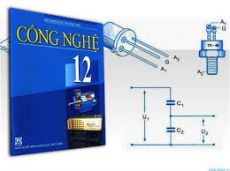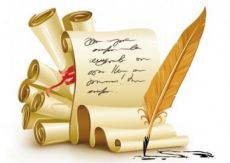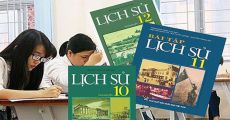Read the passage and mark the letter A, B, C, or D on your answer sheet to indicate the correct answer to each of the questions from 7 to 14.
The sculptural legacy that the new United States inherited from its colonial predecessors was far from a rich one, and in fact, in 1776 sculpture as an art form was still in the hand of artisans and craftspeople. Stone carvers engraved their motifs of skulls and crossbones and other religious icons of death into the gray slabs that we still see standing today in old burial grounds. Some skilled craftspeople made intricately carved wooden ornamentations for furniture or architectural decorations, while others carved wooden shop signs and ships' figureheads. Although they often achieved expression and formal excellence in their generally primitive style, they remained artisans skilled in the craft of carving and constituted a group distinct from what we normally think of as "sculptors" in today's use of the word.
On the rare occasion when a fine piece of sculpture was desired, Americans turned to foreign sculptors, as in the 1770's when the cities of New York and Charleston, South Carolina, commissioned the Englishman Joseph Wilton to make marble statues of William Pitt. Wilton also made a lead equestrian image of King George III that was created in New York in 1770 and torn down by zealous patriots six years later. A few marble memorials with carved busts, urns, or other decorations were produced in England and brought to the colonies to be set in the walls of churches - as in King's Chapel in Boston. But sculpture as a high art, practiced by artists who knew both the artistic theory of their RenaissanceBaroque-Rococo predecessors and the various technical procedures of modeling, casting, and carving rich three-dimensional forms, was not known among Americans in 1776. Indeed, for many years thereafter, the United States had two groups from which to choose - either the local craftspeople or the imported talent of European sculptors.
The eighteenth century was not one in which powered sculptural conceptions were developed. Add to this the timidity with which unschooled artisans originally trained as stonemasons, carpenters, or cabinetmakers - attacked the medium from which they sculpture made in the United States in the late eighteenth century.
Câu 7 : What is the main idea of the passage?
Suy nghĩ và trả lời câu hỏi trước khi xem đáp án
Lời giải:
Báo saiÝ chính của đoạn văn là gì?
A. Có nhu cầu lớn cho công việc của các nghệ nhân thế kỷ thứ mười tám.
B. Các nhà điêu khắc người Mỹ bị cản trở vì thiếu công cụ và vật liệu.
C. Các nhà điêu khắc lành nghề không tồn tại ở Mỹ vào năm 1770.
D. Nhiều nhà điêu khắc nước ngoài làm việc ở Mỹ sau năm 1776.
Thông tin: in 1776 sculpture as an art form was still in the hand of artisans and craftspeople… On the rare occasion when a fine piece of sculpture was desired, Americans turned to foreign sculptors… The eighteenth century was not one in which powered sculptural conceptions were developed.
Tạm dịch: vào năm 1776, điêu khắc như một hình thức nghệ thuật vẫn còn trong tay của các nghệ nhân và thợ thủ công… Trong những dịp đặc biệt cần đến tác phẩm điêu khắc, người Mỹ tìm đến những nghệ nhân nước ngoài… Thế kỉ XVIII không phải thời kì tạo điều kiện cho điêu khắc phát triển.
Câu 8 : It is stated in the first paragraph that the sculptural legacy that the new United States had from colonial times was ______.
Suy nghĩ và trả lời câu hỏi trước khi xem đáp án
Lời giải:
Báo saiĐược nêu ra trong đoạn đầu tiên rằng di sản điêu khắc mà Hoa Kỳ mới có từ thời thuộc địa ______.
A. không vĩ đại, không lớn/nhiều
B. dồi dào
C. rất giàu
D. không đếm được
Thông tin: The sculptural legacy that the new United States inherited from its colonial predecessors was far from a rich one
Tạm dịch: Di sản điêu khắc mà nước Mĩ kế thừa từ tổ tiên thời kì thuộc địa không thể coi là dồi dào
Câu 9 : The phrase “turned to” in paragraph 2 is closest in meaning to ______.
Suy nghĩ và trả lời câu hỏi trước khi xem đáp án
Lời giải:
Báo saiCụm từ “turned to” trong đoạn 2 có nghĩa gần nhất với ______.
A. castigated: trau chuốt, gọt giũa
B. censored: bị thiếu
C. consulted: tra cứu, tham khảoD. hired: thuê, mướn turn to: tìm đến, chuyển sang
Thông tin: On the rare occasion when a fine piece of sculpture was desired, Americans turned to foreign sculptors, as in the 1770's when the cities of New York and Charleston, South Carolina, commissioned the Englishman Joseph Wilton to make marble statues of William Pitt.
Tạm dịch: Trong những dịp đặc biệt cần đến tác phẩm điêu khắc, người Mỹ tìm đến những nghệ nhân nước ngoài, như vào những năm 1770 khi các thành phố New York và Charleston thuộc Nam Carolina, ủy quyền cho một người Anh tên Joseph Wilton khắc tượng William Pitt bằng cẩm thạch.
Câu 10 : The work of which of the following could be seen in burial ground?
Suy nghĩ và trả lời câu hỏi trước khi xem đáp án
Lời giải:
Báo saiCông việc nào sau đây có thể được thấy ở bãi chôn lấp?
A. chạm khắc đá
B. thợ mộc
C. thợ đóng đồ gỗ
D. nhà điêu khắc châu Âu
Thông tin: Stone carvers engraved their motifs of skulls and crossbones and other religious icons of death into the gray slabs that we still see standing today in old burial grounds.
Tạm dịch: Thợ khắc đá đã chạm khắc các thiết kế đầu lâu, xương chéo và các biểu tượng tôn giáo khác liên quan đến cái chết lên các phiến đá màu xám mà ngày nay chúng ta vẫn thấy trong những di tích chôn vùi dưới lòng đất.
Câu 11 : The word “they” in the passage refers to ______.
Suy nghĩ và trả lời câu hỏi trước khi xem đáp án
Lời giải:
Báo saiTừ “they” trong bài đọc ám chỉ ______.
A. trang trí bằng gỗ
B. thợ thủ công lành nghề
C. trang trí kiến trúc
D. bảng hiệu cửa hàng gỗ
Thông tin: Some skilled craftspeople made intricately carved wooden ornamentations for furniture or architectural decorations, while others carved wooden shop signs and ships' figureheads. Although they often achieved expression and formal excellence in their generally primitive style, …
Tạm dịch: Một số thợ thủ công lành nghề đã tạo ra những tác phẩm khắc gỗ tinh xảo để trang trí nội thất hoặc kiến trúc, trong khi đó, những người khác khắc gỗ thành biển hiệu cửa hàng và tượng gắn mũi tàu. Mặc dù họ đạt được sự biểu đạt và tính ưu tú về hình thức với phong cách nhìn chung còn thô sơ của mình, …
Câu 12 : The word "commissioned" in paragraph 2 refers to _________.
Suy nghĩ và trả lời câu hỏi trước khi xem đáp án
Lời giải:
Báo saiTừ "commissioned" trong đoạn 2 đề cập đến _________.
A. enabled: đã cho phép B. allowed: đã cho phép
C. conferred: đã phong, đã ban
D. empowered: đã trao quyền
Thông tin: On the rare occasion when a fine piece of sculpture was desired, Americans turned to foreign sculptors, as in the 1770's when the cities of New York and Charleston, South Carolina, commissioned the Englishman Joseph Wilton to make marble statues of William Pitt.
Tạm dịch: Trong những dịp đặc biệt cần đến tác phẩm điêu khắc, người Mỹ tìm đến những nghệ nhân nước ngoài, như vào những năm 1770 khi các thành phố New York và Charleston thuộc Nam Carolina, ủy quyền cho một người Anh tên Joseph Wilton khắc tượng William Pitt bằng cẩm thạch.
Câu 13 : What can be inferred about the importation of marble memorials from England?
Suy nghĩ và trả lời câu hỏi trước khi xem đáp án
Lời giải:
Báo saiCó thể được suy luận điều gì về việc nhập khẩu đài tưởng niệm bằng đá cẩm thạch từ Anh? A. Tác phẩm điêu khắc như vậy để sản xuất tại địa phương thì tốn kém hơn là nhập khẩu.
B. Tác phẩm điêu khắc như vậy có uy tín như những sản phẩm làm tại địa phương.
C. Tác phẩm điêu khắc như vậy không có ở Mỹ.
D. Các vật liệu được tìm thấy ở nước ngoài thì cao cấp.
Thông tin: A few marble memorials with carved busts, urns, or other decorations were produced in England and brought to the colonies to be set in the walls of churches - as in King's Chapel in Boston.
Tạm dịch: Một số ít các tác phẩm bằng cẩm thạch gồm tượng bán thân, bình hoặc các vật trang trí khác được sản xuất tại Anh và mang tới các thuộc địa để đặt trong tường các nhà thờ, ví dụ như nhà thờ King’s Chapel ở Boston (địa điểm này ở Mỹ).
Câu 14 : How did the work of American carvers in 1776 differ from that of contemporary sculptors?
Suy nghĩ và trả lời câu hỏi trước khi xem đáp án
Lời giải:
Báo saiTác phẩm của thợ chạm khắc người Mỹ năm 1776 khác với tác phẩm của các nhà điêu khắc đương đại như thế nào?
A. Nó ít tốn thời gian hơn.
B. Nó đắt hơn.
C. Nó ít lỗi lạc, tinh chế hơn.
D. Nó nguy hiểm hơn.
Thông tin: But sculpture as a high art, practiced by artists who knew both the artistic theory of their Renaissance-Baroque-Rococo predecessors and the various technical procedures of modeling, casting, and carving rich three-dimensional forms, was not known among Americans in 1776. Indeed, for many years thereafter, the United States had two groups from which to choose - either the local craftspeople or the imported talent of European sculptors.
Tạm dịch: Nhưng nghệ thuật điêu khắc cấp cao, thực hiện bởi các nghệ nhân có hiểu biết về cả lý thuyết kiến trúc Baroque-Rococo thời Phục Hưng và các kĩ năng chế tác như làm mẫu vật, đổ khuôn và khắc 3D, lại không được biết đến bởi người Mỹ những năm 1776. Thực tế, nhiều năm sau đó, Mỹ vẫn có hai nhóm người để chọn lựa: thợ thủ công địa phương và những nghệ nhân điêu khắc tài năng đến từ châu Âu.
Đề thi thử tốt nghiệp THPT QG môn Tiếng Anh năm 2020
Trường Chuyên Bắc Ninh












